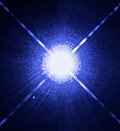Sirius
De LibreFind
| Advanced search |
- About 4 results found and you can help!
 A simulated image of Sirius A and B using Celestia |
Sirius is the brightest star in the night sky. With a visual apparent magnitude of −1.46, it is almost twice as bright as Canopus, the next brightest star. The name "Sirius" is derived from the Ancient Greek: Seirios ("glowing" or "scorcher"). The star has the Bayer designation Alpha Canis Majoris (α CMa). What the naked eye perceives as a single star is actually a binary star system, consisting of a white main sequence star of spectral type A1V, termed Sirius A, and a faint white dwarf companion of spectral type DA2, called Sirius B. The distance separating Sirius A from its companion varies between 8.1 and 31.5 AU.
- See also: Wikipedia, Wiktionary, Commons
- Related: Sothic cycle
| Professor Kaler's webpage on Sirius Professor Kaler's webpage on Sirius www.astro.uiuc.edu/~kaler/sow/sirius.html - Web |
| Astronomy Picture of the Day of Sirius B in x-ray Astronomy Picture of the Day of Sirius B in x-ray apod.nasa.gov/apod/ap001006.html - Web |
| Discussion on Dogon issue Discussion on Dogon issue chandra.harvard.edu/chronicle/0400/sirius_part2.html - Web |
Gallery for «Sirius»
- Yoonir-Symbole de l'Univers.jpg
Average relevance
| Sirius time Sirius time www.johnsankey.ca/siriustime.html - Web |


